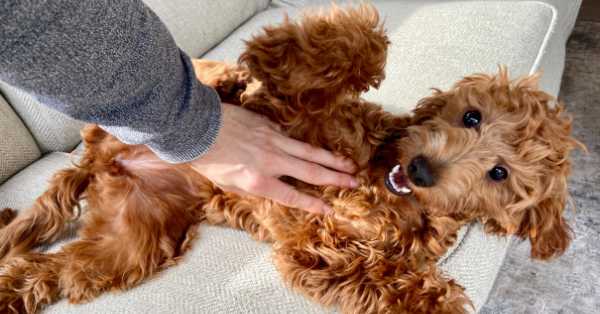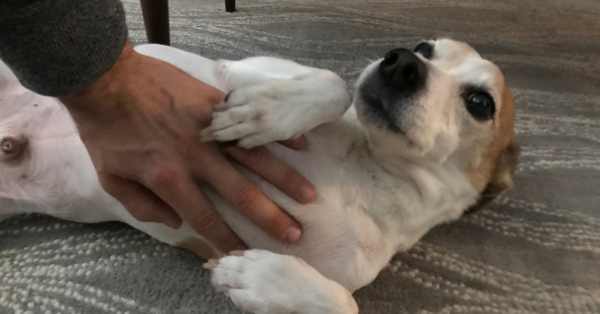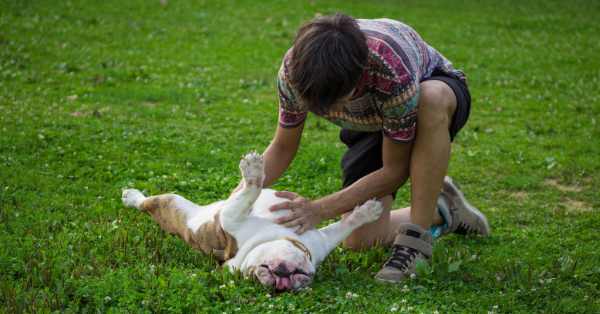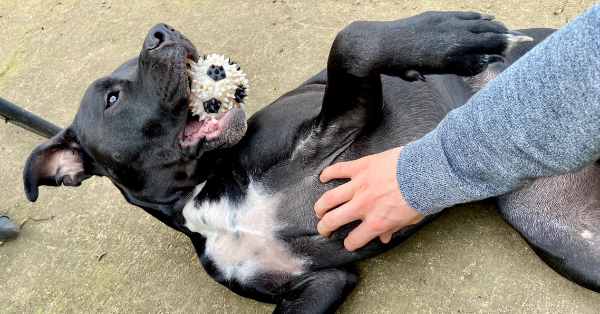Cuddling your pet is one of the best things about pet ownership and belly rubs are a favorite activity for many of our dogs. They cheerfully flop on their backs, tongues lolling and tails wagging, as they await for their tummy scratches.
Yet why? What could possibly be so amazing about rubbing their stomach? And what does it indicate if your dog doesn’t appreciate belly rubs? Is this something to be worried about?
Read on!

What makes dogs want their bellies stroked?
We cannot ask our dogs, so it is hard to pinpoint the precise reason why dogs enjoy belly massages. Dogs are more inclined to seek human assistance because they cannot easily scratch their own tummies.
Many dogs also like scratching their backs by rolling in carpet or grass. Anecdotally, it appears that many dogs love having their bellies rubbed while scratching their backs. With their hind feet, they can reach their own shoulders, necks, and faces. But they do not have a nice way to scratch their own tummies!

Consider how pleasant it is to have someone scratch an itchy spot on your body that you are unable to reach. It makes sense why dogs enjoy receiving belly rubs from their owners.
As we previously stated, your dog is demonstrating a tremendous deal of trust when it exposes the delicate and vulnerable portion of its belly. A dog will typically expose their belly as a clear invitation for you to lean in and give them a belly rub.
The feel-good hormone endorphin and the bonding hormone oxytocin will both be released if your dog enjoys the belly massages. This concoction of lovable, feel-good chemicals will deepen your relationship with your dog and make them feel safe, cherished, and delighted.
In addition to helping your dog internally, affection in the form of belly massages (as well as rubs on the rest of the body too) also helps your dog outwardly by stimulating the hair follicles. An attractive, lustrous coat results from healthy follicles. Win!
Despite all of that, there is not truly a way for us to determine why some dogs adore belly massages. According to one belief, dogs do not love belly rubs at all, and the only reason they accept them is because they believe it makes people happy.
Submissive Behavior vs. Wanting a Belly Rub

Just like not all humans enjoy having their backs tickled, we will start by stating that not all dogs enjoy getting their bellies rubbed. It depends on individual preference. Therefore, if your dog dislikes the traditional tummy tickle, you should not worry. It simply implies that your dog will choose to receive tactile attention from you in other ways.
A dog is showing a lot of trust when they fling themselves at your feet, exposing their tender stomach to you. It is their way of communicating, “This is me at my weakest. I trust you would not do me any harm. Consider it to be a dog’s version of a trust fall.
Prior to caressing your dog, it is crucial to understand what they are trying to tell you.
Dogs who assume a submissive posture, also known as an appeasing posture, are attempting to relieve social tension by demonstrating that they pose no threat. When you pet a dog who is exhibiting submissive or appeasing behaviors, the dog may get more tense since you are now touching him in extremely sensitive areas of his body!
Does my dog want a belly rub?
Dogs who genuinely want a belly rub will typically exhibit the body language indications described below:
- Overall, wiggly, loose body postures
- Mouth: relaxed, open, with their tongue possibly dangling around
- Eyes: bright, open, or squinting, but not necessarily fixed on anything
- Tail: wagging, relaxed tail
- Vocalizations: a mild panting noise, a low “laugh” sound, or silence

A dog exhibiting appeasing or submissive behavior, on the other hand, will appear as follows:
- In general, they have low, rigid body postures and may squat, freeze, or tens up.
- Mouth: mouth closed, or lips pushed back far in a “fear grimace.” There may be a lot of lip-licking and tongue-flicking.
- Eyes: They will either be wide open and focused on something far away, or they will be fixed on you without shifting their head, or their eyes will be strained and squinty.
- Tail: The tail may be tucked or motionless, but it will always have tension at its base.
- Whining that is subdued or gentle
Most people find it easier to look at the dog’s mouth and tail but bear in mind that a happy dog does not necessarily have a tail that is wagging. A full-body, loose tail wag differs from a tucked, stiff, quick tail wag.
Studying Back Rolling Behavior in Dogs
Especially when other dogs are nearby, a dog turning over on his back does not always indicate that the animal is being playful, submissive, or seeking a belly rub.
There are dogs who roll over for belly rubs, and there are dogs who do it for something completely different. If a dog is terrified or anxious, it might roll over for you. It is a submission gesture frequently employed to subdue an aggressor.
Dogs may also turn over to scratch their own backs on the ground. You can usually spot this behavior because dogs like to move around a lot when receiving some good back scratches.

In 2015, two research teams from the University of South Africa and the University of Lethbridge in Alberta set out to look into the purpose and significance of dogs rolling over while playing with other dogs.
The goal of the study was to determine if a dog turning over onto its back is indeed an expression of submission intended to quell hostility or a combative maneuver.
A medium-sized female dog and 33 dogs of various kinds and sizes were matched up for play sessions while the researchers watched recordings of dogs playing together. They then took a seat and looked on.
The researchers concluded that although dogs might roll when playing, the action could also be exploited to an advantage in combat. None of the dogs seen rolled over in a submissive response to aggressive conduct by another dog. Dogs rolling on their backs in front of other dogs were observed to adopt this stance to deflect playful bites and launch attacks at the instigator.
Ensure that you are accurately understanding your dog’s body language in this situation. Your dog is likely not lying on its back for the belly rubs, but rather to demonstrate to you that they are submitting to you if they are showing signs of fear (tail tucked in, ears back, etc.).
Should I pet the bellies of every dog I come across?
Even if you believe you are getting the go-ahead from the dog when you first meet them, refrain from giving them a belly rub right away. When you are certain that the dog has warmed up to you, start with head rubs and work your way up from there.
Dogs enjoy belly massages because they are a more personal type of physical touch than hugs are for people. You would not just get right into a bear hug with a total stranger, would you?
Should You Rub Your Dog’s Belly?

Owners should feel free to pet their pets whenever they are happy to get belly rubs. However, Dr. Peter Brown, chief medical officer of Wagly, a veterinary-based pet service provider with campuses in California and Washington, cautions that a dog who suddenly doesn’t enjoy a good belly rub may be trying to say something else.
“If your dog generally enjoys belly massages and then stops, it could be an indication of a sore belly or a problem with their back.”
Some dogs, however, can live without frequent stomach rubbing.
Christine Case, an anthrozoology instructor at Beacon College in Leesburg, Florida, explains that a dog’s preference for an activity may depend on their prior experiences.
“A dog’s dislike of belly rubs does not necessarily indicate that something is wrong; it could simply be the dog’s choice. It depends on the particular animal.
However, most experts believe that when dogs request belly rubs or other forms of caressing, it shows how at ease they are as members of the family.
Michael Schaier, a certified professional dog trainer and author, adds, “The contact of your hand is the best reward you can give your dog.
How to Give a Dog a Great Belly Rub
Many dogs like to have their bellies scratched in the morning, when their serotonin levels are at their highest, or when they’re already feeling relaxed.
Learning how to provide a decent belly rub might help your dog adore belly rubs even more. The basic steps for a great belly rub are as follows:
1. Confirm if your dog is interested in it. Watch out for your dog’s cues that he needs a belly rub.
2. If your dog loses interest or doesn’t appear to be interested in rubs, do not push it. By showing you their belly, your pup has invited you into their circle of trust; do not overstay your welcome or invade over the boundary your dog is laying down.
3. Get on the level. Sit on the ground or kneel to become low. Your dog will feel more exposed if you hover above them like a shadow. Dogs may sense your mood, so keep it cool and r emain at ease.
4. Start slowly. Do not go for the belly right away. From the sides or the head, work your way there. Read the environment; your dog’s response will indicate whether you’re doing it correctly.
5. Use an open, flat palm to massage the tummy. On delicate belly skin, especially around the nipples, use fingernails with caution. Swap out flat palmed strokes for circular massages, delicate scratches, and the occasional consoling “good-dog” side pat.
6. Avoid repeating the same action over an extended period of time. When you break off all touch, vary it up and take numerous breaks.
7. Your dog will give you the “keep going” paw or the “do not stop” snout nudge when you stop if they are having a good time. Thus, you are aware to continue.
8. Cover the full belly. Try a few different tempo and technique variations.

